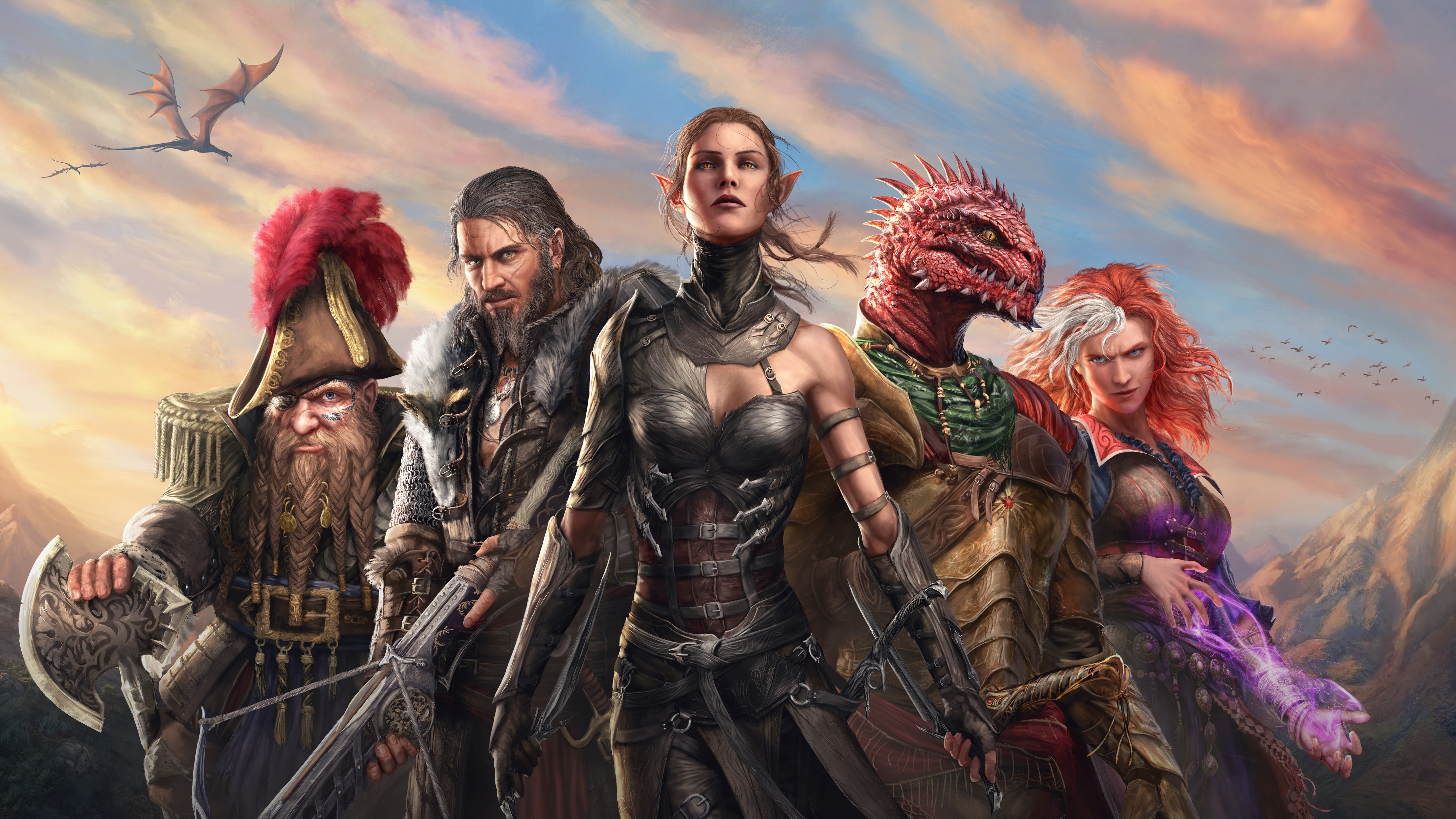How Larian revised Divinity: Original Sin 2’s final act
Swen Vincke talks to us about Dwarves, noble squirrels and moving onto new things after Definitive Edition.

Divinity: Original Sin 2 might be an exceptional RPG—not to mention PC Gamer’s 2017 game of the year—but after its launch last year, Larian Studios still thought it had room for improvement. With a console release on the cards, the developer set about working on Divinity: Original Sin 2 Definitive Edition.
“Once we saw it was doing well and we were certain we were going to make the console versions, we knew that was the right moment,” says Larian’s founder, Swen Vincke. “We had an opportunity to fix some of the things that had been bugging us during development.”
It wasn’t just a chance for the developer to fix its own bugbears; players had their own criticisms that Larian wanted to address. Most notable among them was the final act.
“One of the key criticisms was that Act 3 wasn’t as cool as the others, and we could sympathise with that,” says Vincke. “So we asked a couple of our narrative designers to go through it and told them to be very heavy with their criticism. They came back with a 48-page document. They asked what they should fix, and we just said, ‘Do everything.’ So that’s what they did.”

Unleashing Beast
The improvements to Act 3 should be most apparent with Beast, the Dwarven seadog, in the party. One of Original Sin 2’s neatest features is its origins system. A character’s background opens up all manner of new conversations, quests, alternative paths and plenty of flavour, but some of that was missing for Beast in Act 3. He meets a lot of fellow Dwarves, but that doesn't result in as much unique dialogue options or reactivity as you might expect. Fixing that was a priority, with the Definitive Edition's version of Beast’s storyline being filled with little details to set it apart.
It’s the classic problem: the part that gets played the most in QA sessions is the beginning.
One of the challenges Larian had encountered when it designed Act 3 initially was just testing it. There were so many ways that players could reach it, so many potential paths to keep track of, that blind spots were inevitable.
“It’s the classic problem: the part that gets played the most in QA sessions is the beginning,” says Vincke. “Every large RPG has this problem. I was talking to BioWare about Dragon Age and asked them how they tested their endings and all the permutations. It's an issue because we put so many choices in our games, and in the end they all have to come through. Has QA seen every single line that’s possible? It’s impossible to do so. They bifurcate, and we have ways of dealing with that, but actually having someone playing through all these lines? It’s mathematically impossible.”
Keep up to date with the most important stories and the best deals, as picked by the PC Gamer team.
With Original Sin 2 out in the wild, there were legions of players taking all sorts of routes with different characters and party combinations, revealing the places where Larian felt it could shore up some gaps. The final act’s antagonist has been beefed up narrative-wise and the epilogue provides more closure. More generally, says Vincke, the goal was to add an additional layer of polish and clarity to the narrative.
Yet the nature of Divinity means that a lot of these improvements might be less noticeable, depending on the path you take. “For some people it will be pretty much the experience they had before, but for some people it will be dramatically different,” explains Vincke. It’s a chunky update, but it's not an overhaul. “Fundamentally the content is the same.”
Taking notes
While Larian’s writers and voice actors worked on the story and dialogue, tweaks were being made to fights and visual effects, balance was being revisited, a new tutorial was being designed and the arena was getting a hotseat mode, along with new levels. There’s a huge document detailing all the changes, if you’ve got the patience to go through it all. And then there was the journal.
“We redesigned the entire journal for the Definitive Edition,” says Vincke. “A couple of souls really put a lot of effort into that. We’ve got really high review scores, but if there’s one bit of criticism coming in, it’s the fucking quest log. They say it’s still a little bit vague, but we can’t make it more precise because there are so many ways you can approach things.”

Larian caught a bit of flack for the journal the first time around, too, prompting the redesign, but while Vincke agrees that it's not always clear, the quests aren't designed in such a way that the journal could guide players through them.
“We design our quests in a way that’s different from a lot of other RPGs,” Vincke explains. “We say that you came from A, you came to B, but we have no clue how you got from A to B. We just know that you arrived at B. So we just assume that you did something to overcome all the challenges and we get on with our lives. But what Original Sin 2 does not tell you is how to get from A to B. The original quest entry in Act 1 told you to ‘get off the island’. Then we thought we should maybe give players a few more pointers. It would have been awesome if that had been the only quest in your journal, though.”
Shortcuts
Some fixes were purposefully not made. Players have discovered lots of exploits and quirks and clever but unintended solutions to conundrums—to Vincke they're both a testament to player ingenuity and the skill of the designers. The world works in a largely logical way—as logical as a world with magic and talking skeletons can work—even when players are coming up with things that have never been considered. And this started right when people first got their hands on the game.
Vincke recalls Original Sin 2’s first reviewer managing to sidestep an end-game problem in a way that made complete sense and also worked, taking Larian by complete surprise. It's a nifty trick that I won't spoil here. And there are other tricks, too, like stacking chairs to get a height advantage, and all the wonderful things you can do with teleportation, a skill so handy it sometimes feels like an exploit even when it’s working as intended.

The Definitive Edition is available now as a free upgrade on PC, though it's accompanied by some very cheap DLC: Sir Lora. The titular character is a knight who is also a squirrel. His mount is an undead cat. And yes, he can join your party. Since he's a squirrel, you'll need the Pet Pal skill to chat to him, learning about his heroic quest involving the Great Acorn and the end of the world. He's quite invested in it.
With another character comes more things Vincke would like to improve. Given that Sir Lora views his companions as, at least initially, dim-witted minions helping on his quest, I wonder if there might be some extra friction with Red Prince, since he's also got a pretty high opinion of himself. Vincke quickly quizzes his designers and is clearly disappointed when he confirms that the pair don't have any interactions like that. There's no time for Definitive Edition 2, however. Larian is ready to move on.
“It’s not as if we didn’t talk about adding new quests or a new origin character, but we only have so much time in our lives and there’s only that many things we can make,” explains Vincke. “We’ve already put a lot of effort into improving what’s there. People forget that these are three-year endeavours for us, and when you think about your lifecycle, you start counting how many you can make. It’s not that many. That’s why we need to move on and make new stuff.”

Fraser is the UK online editor and has actually met The Internet in person. With over a decade of experience, he's been around the block a few times, serving as a freelancer, news editor and prolific reviewer. Strategy games have been a 30-year-long obsession, from tiny RTSs to sprawling political sims, and he never turns down the chance to rave about Total War or Crusader Kings. He's also been known to set up shop in the latest MMO and likes to wind down with an endlessly deep, systemic RPG. These days, when he's not editing, he can usually be found writing features that are 1,000 words too long or talking about his dog.

